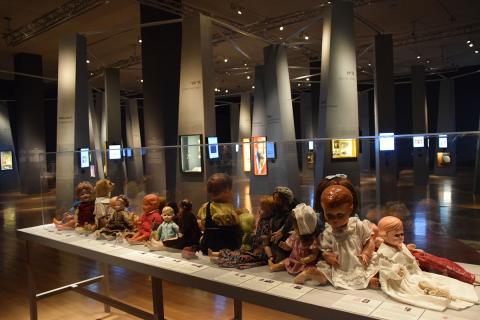Yad Vashem’s ‘Living Memory’ exhibition
Together, they form a mosaic of loss, faith, and survival, gathered over decades by the world’s foremost Holocaust remembrance center. The exhibition traces the evolution of remembrance – from the intimate, personal items of those who lived through the Shoah to the meticulous efforts of survivors and historians who have preserved memory for future generations.
Interactive stations allow visitors a behind-the-scenes glimpse of how Yad Vashem continues to collect, preserve, and catalogue materials from across the world, ensuring that commemoration never fades with time.
Stories Carved in Courage
Among the more than 400 objects on display are items that tell extraordinary stories of courage and survival. In one corner stands a full-sized wardrobe salvaged from a Polish home, its wooden door punctured by a German soldier’s bayonet – the same wardrobe where Jewish teenager Genia Sznajder hid in 1941.
Nearby looms a hollowed-out tree trunk that concealed Jakob Silberstein for days in a Czech village as he fled Nazi patrols. Equally striking is a Shabbat candelabra fashioned from barbed wire at the Mauthausen concentration camp by prisoner Azriel Yitzhak Shunner. In that makeshift menorah, Shuner lit tiny wood chips each week to mark Shabbat, a fragile act of spiritual defiance.
He shared the story only on his deathbed.
The exhibition’s opening ceremony, scheduled for this Thursday, October 30, will feature a moving performance by 104-year-old Auschwitz survivor and conductor László Roth, whose presence embodies the exhibition’s central idea: the enduring link between past and future.
AMONG THE most haunting – and personal – items in the exhibition is a small metal spoon. It once belonged to my uncle, Arthur Poznanski, born in Praszka, Poland, in 1927. During the Holocaust, Arthur worked in the Hortensia glass factory in Bugaj and endured the brutal camps of Buchenwald, Schlieben, and Flossenbürg.
In 1945, as the Nazis evacuated prisoners toward Mauthausen, Arthur leapt from a moving train in a desperate bid for freedom. A guard opened fire. The bullet struck the spoon in his pocket, ricocheted, and spared his life.
Gravely wounded but alive, Arthur crawled to a nearby Czech village, where locals found and hospitalized him. Eventually, he reunited with his brother Jerzy in Theresienstadt and was brought to England in August 1945 as part of the first group of Holocaust child survivors, later known as “The Boys.”
Organized by Leonard Montefiore, the United Nations Relief and Rehabilitation Administration (UNRRA), the American Jewish Joint Distribution Committee (JDC), and the Central British Fund, the mission brought 301 children from Theresienstadt to the UK aboard RAF bombers.
They landed at Windermere in the English Lake District on August 14, 1945, to begin new lives after their unimaginable suffering. United by trauma but bound by resilience, The Boys would remain a lifelong brotherhood, dedicated to remembrance and renewal.
Arthur rebuilt his life with music and dignity. A professional singer before entering the textiles trade, he became a beloved figure in his community, his voice filling synagogue choirs and local halls with hope.
He married my mother’s sister, Renée Rudolf, in 1960, and together they raised two children, Angela and Victor. Arthur passed away in 2009, leaving behind a family whose lives continue to echo his courage.
Preserving Memory for the Future
The spoon’s inclusion in Yad Vashem’s new exhibition reflects not only a story of survival but also the living nature of remembrance itself. When I visited the museum’s Collection Center earlier this year for The Jerusalem Post Podcast – Travel Edition, curator Michael Tal had laid out a dozen artifacts in preparation for a group visit.
By chance – or perhaps fate – Arthur’s spoon lay front and center. As Michael recounted my uncle’s story, he invited me to hold the spoon for the first time. I remember slipping on a pair of protective gloves and lifting it carefully from the table. Cameras clicked softly as Yad Vashem chairman Dani Dayan and the PR team looked on. It was a moment that felt like a reunion – an encounter across generations, bridging history and the present.
For Yad Vashem, such artifacts are far more than relics; they are vessels of meaning. Each item is a portal into an individual life, a fragment of a greater story that connects personal resilience with collective memory. As Israel pauses amid uncertainty, Living Memory stands as a reminder that history is not only what we inherit, but also what we choose to carry forward. The spoon that once stopped a bullet now carries another kind of weight – the enduring responsibility to remember.
As Dayan said in January, “When the last survivors die out, it will be the ’happy hour‘ of deniers and distorters, so the story must have a solid platform. A story that is more relevant than ever in the modern world.
Mark Gordon

